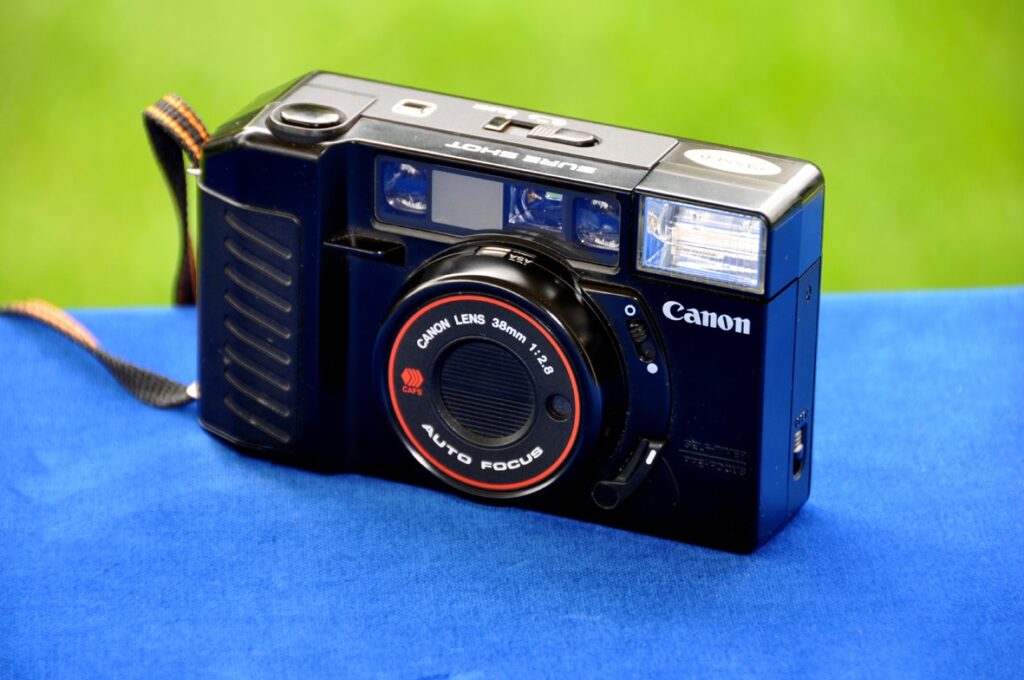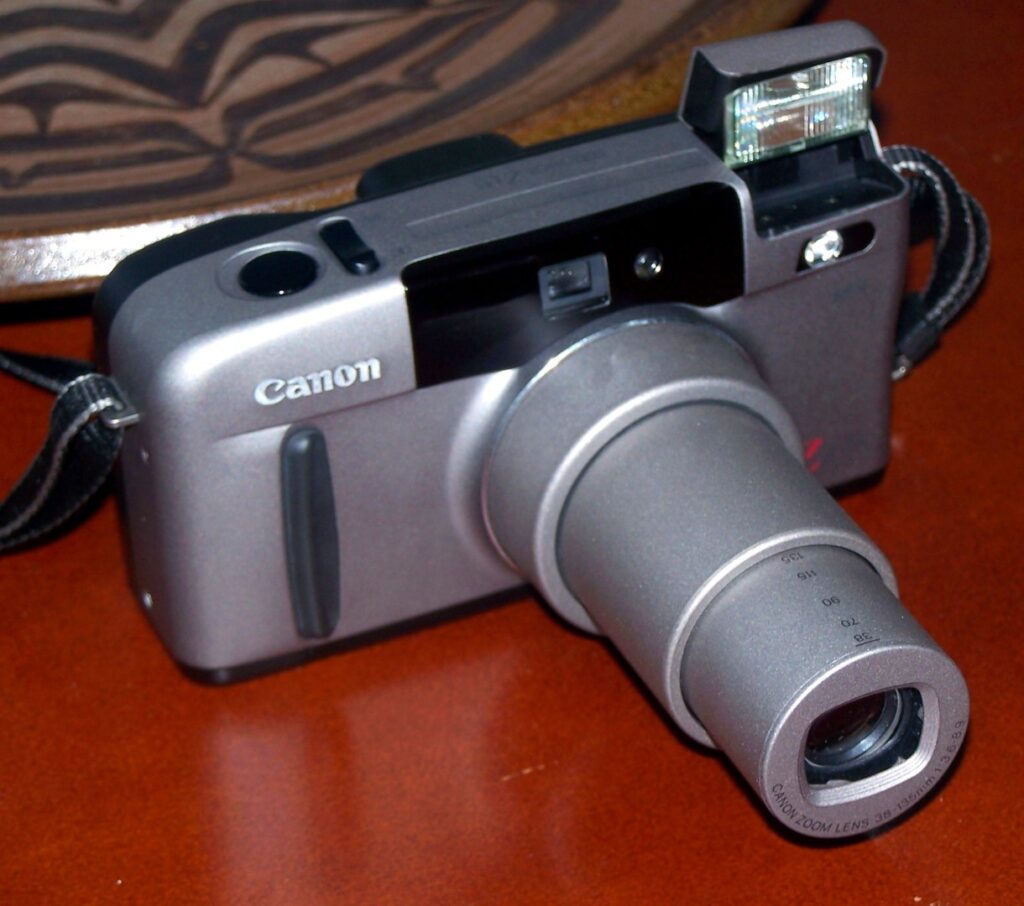
In the world of photography, few innovations have made as significant an impact as the introduction of autofocus technology. As photographers aimed to capture spontaneous moments with increasing precision, the demand for cameras that could automatically and accurately focus on the subject grew. Enter the Canon Sure Shot, known as the AF35M in Europe and the Autoboy in Japan. This remarkable piece of engineering wasn’t just another camera; it marked a paradigm shift in the way photographers approached their craft.
Design and Features
The Canon Sure Shot/AF35M/Autoboy boasts a sleek and functional design, catering to both aesthetics and utility. Its significant features, such as the lens and viewfinder, reflect Canon’s dedication to quality and innovation. But where this camera truly stands out is in its revolutionary autofocus capability. In 1979, when the AF35M was introduced, it became an early herald of the active autofocus era. While the Konica C35 AF had dipped its toes into autofocus technology two years prior with a passive system, it was the AF35M’s active CAFS (Canon Auto Focus System) that came to set the gold standard. Using a near-infrared emitting diode (IRED) and a photo diode receiver, this camera could determine the distance to the subject and adjust the lens accordingly, a feat that was groundbreaking at the time.
Its significance is further amplified when you consider its place in the lineage of Canon’s cameras. The AF35M was the inaugural model in Canon’s acclaimed Sure Shot/Prima/Autoboy series, which would go on to see numerous iterations, each building on the success of its predecessor. This camera wasn’t just a product; it was a statement of Canon’s vision for the future of photography.
Film and Film Format
Before digital cameras became commonplace, the film was a crucial component that captured and immortalized moments. The Canon Sure Shot/AF35M/Autoboy proudly utilized the 35mm film format, a classic in photography circles. This format was known for striking a fine balance between the physical size of the film and the quality of images it produced, making it apt for the AF35M’s goal of blending compactness with quality.
However, the choice of film format is just one piece of the puzzle. The camera’s compatibility with a range of film speeds, from 25 to 400 ISO, added another layer of versatility. This range allowed photographers to select films based on their shooting conditions. In bright sunlight, a lower ISO film like Kodak Portra 160 or Kodak Gold 200 would be ideal. For more overcast or indoor settings, a higher ISO film, such as the Kodak Tri-X 400 or Ilford HP5 Plus, could be chosen.
Battery and Power Management
The Canon Sure Shot/AF35M/Autoboy underwent changes in its power source over its lifecycle. Initially, it operated on two AA batteries, a common and readily available power source that provided users with both convenience and cost-efficiency. These alkaline batteries were known for their longevity, ensuring that photographers could use the camera for extended periods without frequently replacing or recharging them.
However, in some of the later models, Canon transitioned to using a single 2CR5 battery. This lithium-based battery, while being more specialized than its AA counterparts, offered a higher voltage and longer shelf life. Its lightweight nature also contributed to reducing the overall weight of the camera, further enhancing its portability. Moreover, the 2CR5 battery’s robust performance, especially in colder environments, ensured consistent camera operations even in less-than-ideal conditions.
User Base: Beginners or Advanced Photographers?
The Canon Sure Shot/AF35M/Autoboy, with its introduction of groundbreaking autofocus technology and its position as the forerunner in the Sure Shot/Prima/Autoboy series, posed an interesting question: Who exactly was this camera designed for?
At a glance, the intuitive features such as the active autofocus system signaled a camera that was ready to be used straight out of the box, even by those who were relatively new to photography. This autofocus system, as opposed to the manual focusing methods of many cameras at the time, reduced barriers to entry, allowing even the most inexperienced photographers to capture sharp images without delving deep into the intricacies of manual focus techniques. Add to this the camera’s ability to handle a wide range of film speeds and its automated systems, and it’s clear that the AF35M was tailored to be friendly for beginners.
Yet, it would be an oversight to classify the AF35M as merely an entry-level camera. Its design also catered to more advanced photographers, who could leverage its features to expedite certain processes. The inclusion of features like the pre-focus capability and the programmed shutter and aperture settings indicated that this wasn’t just a point-and-shoot camera but one that allowed for a degree of creative control.

Technical Specifications
| Specification | Details |
|---|---|
| Model | Canon AF35M/Sure Shot/Autoboy |
| Launch Date | November 1979 |
| Lens | 38mm, f/2.8 (4 elements in 3 groups) |
| Autofocus System | CAFS infra-red system with pre-focus capability |
| Viewfinder | Reversed Galilean with frame lines, 0.5× magnification, 85% coverage |
| Film Speed Range | ISO 25 to 400 |
| Shutter | Specific details under Exposure Control |
| Flash | Integral, Guide number 14m at ISO 100 |
| Additional Features | Electronic self-timer, tripod socket, auto load and wind, power rewind with switch |
| Power | two AA batteries |
Conclusion
The Canon Sure Shot/AF35M/Autoboy marks an important moment in Canon’s history, representing one of their early forays into autofocus technology. Designed with both novices and experienced photographers in mind, this camera struck a balance between user-friendliness and functionality. Its features, while not overly complex, provided photographers with a tool that was both reliable and relatively advanced for its time. As we look back, the AF35M stands as a clear indication of Canon’s trajectory towards making photography more approachable while still pushing the boundaries of technology.

